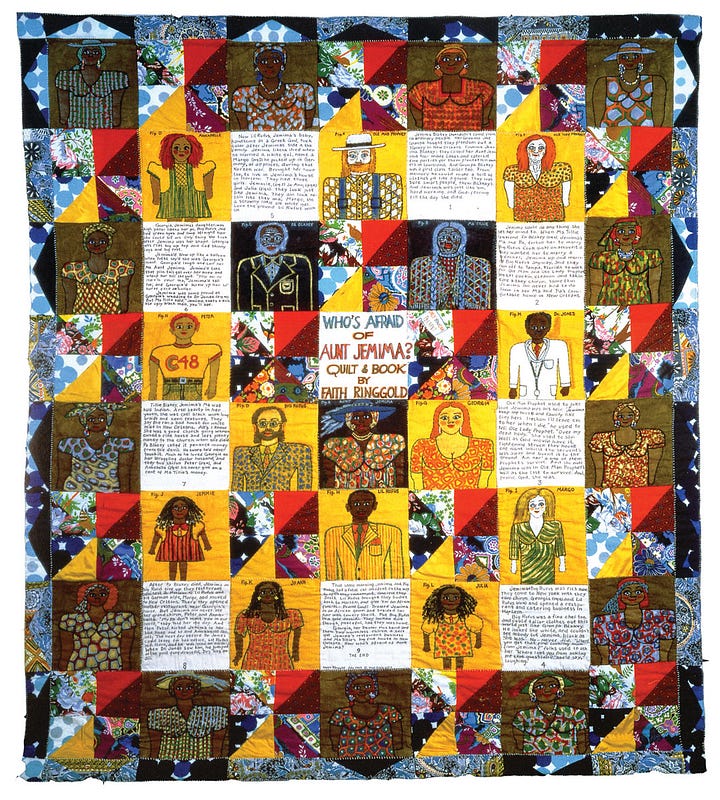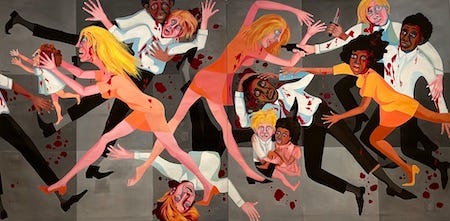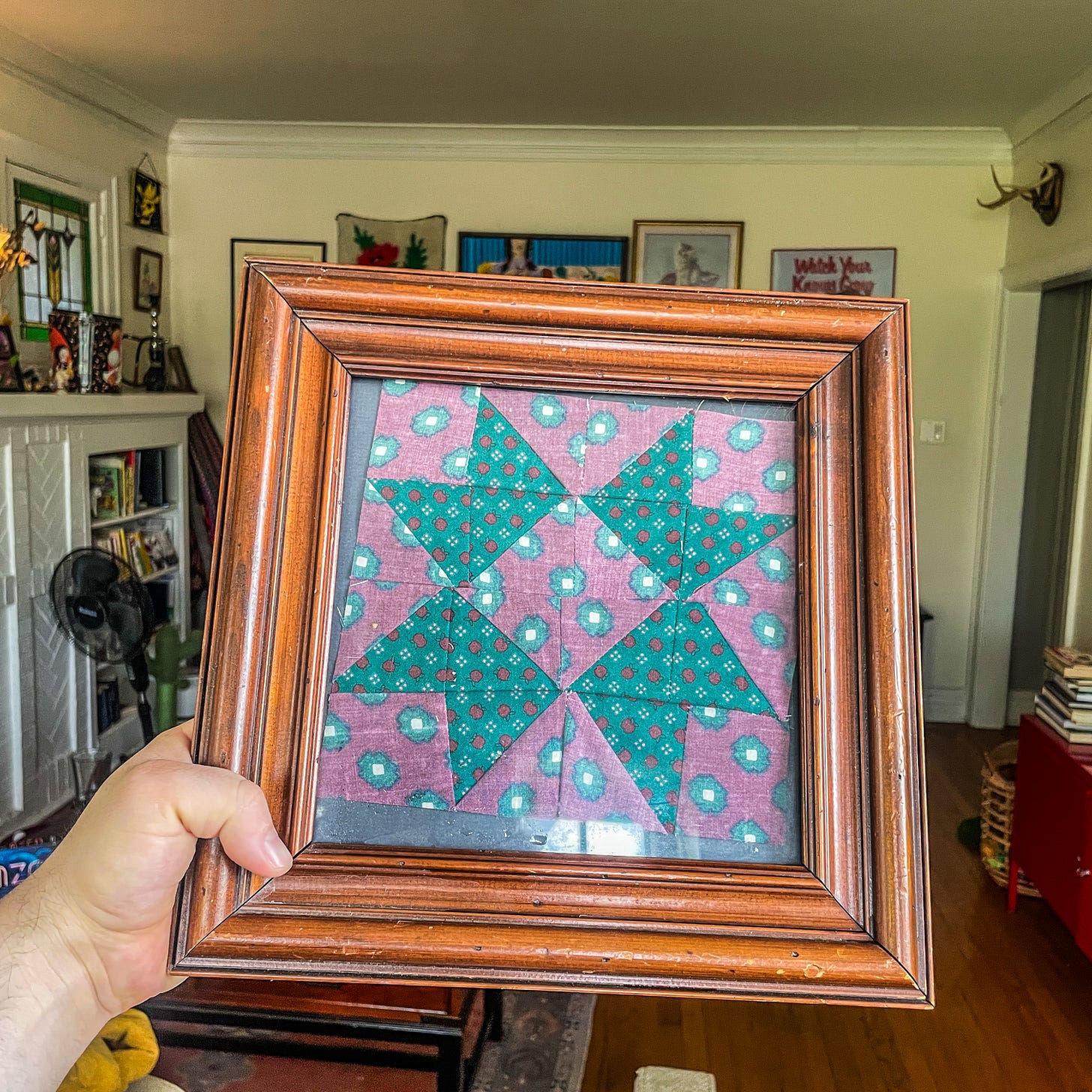The Patchwork Self
Using Art to find identity, conceptualizing generational trauma and finding reconciliation through a lost art form.
Happy Friday!
Once again, thank you for welcoming me into your inbox at the end of every week. I wanted to share a few quick housekeeping items before I dive into this week’s essay.
As a reminder, The Dollhouse Project is now accepting submissions for prompt#1: What's in the attic? You’re free to make submissions for this prompt until May 20, 2024.
I would like to start using this newsletter to highlight folk artists, outsider artists and self-taught artists. I know there’s a lot of cool art being made out there and I want to write about it and show it off! If you or someone you know would be a good candidate for this, please fill out this form
Following this newsletter, I’ll be shifting my publishing day to Sundays to see if that works out better for my schedule.
Check out my updated about me page! This will give you a glimpse into some new directions I’m taking this newsletter in.
I turned 31 this week. For the first time, I see myself clearly. I see myself as a young boy in an uncomfortable suit, sitting in a rigid church pew. I see myself throughout adolescence monitoring every inflection of my voice, every gesture of my hands and every stride to avoid revealing my true identity: I was a pansy. A sissy. In the south we might say I had too much sugar in my britches. I was gay, and it was quite obvious to everyone around me, but also an abomination to everyone around me. I see myself at 18 pulling out of the driveway to leave home without a goodbye from my mother after she’d discovered my secret. Ever since that day, I spent my life rebeling against the identities and expectations imposed against me since the day I was concieved. I gained a very firm understanding of what I was not, but I had absolutely now idea of what I was.
I spent many years tossed about in the waves of life. In rebeling against the identities I was born under, I had nothing left; no legacy, no family history, and no home. I had no mooring, and with every attempt to tie myself down to something stable i was pushed assunder. When I decided to become an artist, these were the themes that kept arising, but I struggled clumsily to give them form. I felt immense embarrassment and shame the more that I tried and failed to express myself as an artist that I nearly gave up. Instead, I perservered and I am becoming stronger in my voice as an artist. I can see myself clearly now. I can look backwards on my life and narrate a new story. This is the real power of art.
I’ve spent the last several years becoming a painter. I never felt truly like a painter, but I wanted to be an artist and in my mind, artists were painters. Very serious and solemn painters are the only artists who count, as you know. ;-) The problem was I was not a very serious artist. And I might not even be a painter! Making art felt terrible most of the time. It felt like a waste of time, a waste of money and the more I became surrounded by stacks of canvases, the more I resented my art. I felt so compelled to find my voice as an artist that I sacrificed nights of sleep for it, time with my partner for it and I drained my bank account for it. At all costs I felt the most intense need to find my voice as an artist. As I celebrated my birthday this week, I experienced a transcendent realization: I am a quilter. I am a quilter and an artist.
I thought becoming an artist would be about becoming extraordinary, but for me this journey is increasingly about becoming more ordinary. As my illusions about my seperateness dissolve, the artist within me emerges and I find the message i’ve been searching for is astonishingly simple. My own voice merges with the whole and becomes an echo of humanity’s cry for what is essential: home, sustinence, joy, community, and truth. This message become muddied with modern life, the struggle for survival and the expectations for artists to promote themselves but I don’t want to promote myself. I want to promote art itself.
This spring I enrolled in a quilting class. I became interested in quilts after seeing Faith Ringgold’s retrospective at the Museum of Contemporary Art here in Chicago. If you’re unfamiliar, Faith Ringgold is an artist who merges the mediums of painting and quilting. Many of her paintings are narrative paintings surrounded by a quilted border with a written story inscribed around the image. I was deeply touched by the sincerity of her work, and her ability to express joy and wonder alongside grusome depictions of violence. It should be noted that Faith Rinngold just recently passed.


On the left, the quilt "Who's Afraid of Aunt Jemima?" reimagines Aunt Jemima as a successful entrepreneur. This was Ringgold's debut quilt, crafted after her painting "Die," which was displayed to the right. Inspired by Picasso’s "Guernica," "Die" confronts the viewer head-on with the harsh reality of the race riots prevalent throughout the 1960s. In an interview, Ringgold reflects on her frustration with how this kind of violence had become commonplace and the lack of media coverage it received. At the exhibition , I was struck by how Ringgold adeptly addresses such challenging subject matter across different mediums. Her transition to quilting mediated her message in a way that felt intimate and approachable, drawing the viewer into a deeper engagement with the narratives she portrays.
Ringgold's work effectively demonstrates that the traditional divide between art and craft is an artificial construct. By elevating quilting—a medium historically categorized as craft—to the same level of artistic expression as painting, often blending the two into one, she challenges preconceived notions about what constitutes 'fine art'. Her ability to traverse these boundaries not only enriches her thematic expressions but also invites a reevaluation of how we perceive and value different forms of artistic practice.
After seeing this exhibition, I became obsessed with quilting. I immersed myself in documentaries and delved into the rich history of quilts, coming to see them as kaleidoscopes of the American experiment—each piece a tapestry of diverse histories, cultures, and personal stories. Quilts, often crafted within the domestic sphere and traditionally seen as a female endeavor, reflect the intricate weave of family life and gender roles. These fabric narratives not only chronicle personal and collective experiences but also highlight the often overlooked contributions of women to art and culture. This realization sparked a personal revelation. As I explored the intricate stories each quilt told, I understood how quilting could offer me a unique medium through which to express my own experiences and identity, connecting the threads of my personal history with broader social themes. I saw the power of bringing the humble quilt off of the bed and onto the museum wall. Quilts are the perfect medium for my story.
This spring I began my quilting class. My mom visited me this past weekend for my birthday and bought me my first sewing machine. My mother and I have had a turbulent relationship for the past 13 years. Our relationship fell apart as I came out as gay, and continued to degrade over the years following our family’s cycle of generational trauma. While she taught me how to thread the machine and troubleshoot tension issues, I shared my new quilting knowlege and showed her how to square up yardage to make quilt blocks.
While we worked, we spoke about my great-great grandmother who was an infamous quilter in our home town. She hand pieced many legendary quilts made from scraps of old clothing and feed bags. She made beautiful objects out of the remnants of her life.
Quilting is becoming a framework to contextualize my own experiences and my place within my family's legacy. I've often felt like a misfit, an outcast who didn’t quite belong anywhere. As a quilter, I see myself as a piece of patchwork within the greater whole. Quilting is the merging of our stories—it's a little of you and a little of me, all stitched together to form something larger and more meaningful than any of us alone could be.

I am no longer searching for a place to fit in; instead, I am focused on creating one. Quilting isn’t just about telling my own story—it opens up a space for others to weave their narratives alongside mine. This is the real power of art: it transcends individual experiences, transforming personal stories into connections that are universally felt, allowing us to be seen and to understand each other on a deeper level.
The journey to becoming an artist is fundamentally a transformation of self—breaking down and reassembling our identities and perceptions to discover something profoundly new. In this process, what starts as a personal quest evolves into an understanding of oneself as part of a larger whole. Ultimately, this journey reveals a poignant truth: our individuality is deeply interconnected with the fabric of the community. In making art, we not only see ourselves but also invite others to truly see us and share in our experience.





I, too, have an incredibly tumultuous relationship with a parent largely due to my sexuality (and the peripherals that come with it) and extremely different perspectives on what it means to be family. I’m sending love, and I’m so happy you’re finding a steadfastness in yourself!
I am really enjoying exploring your substack. Thank you for sharing your journey and ideas x